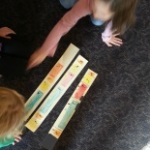 Music class is not the usual place for students to work in small groups. We don’t see them very often or for a long period of time, so we cram in as much as we can in the time we have. Usually, the fewer the transitions, the better! So why bother trying it out?
Music class is not the usual place for students to work in small groups. We don’t see them very often or for a long period of time, so we cram in as much as we can in the time we have. Usually, the fewer the transitions, the better! So why bother trying it out?
Having your kids work in small groups has many benefits. First and foremost, it is great for the kids! They learn to work together without the direct involvement of an adult (this allows the space for students to explore the activity, make mistakes and discuss with their peers what is happening), behavior problems are diminished because every student has a job to do (the opportunity to “zone out” is lessened) and there is time to either work with kids that need a little extra help or taking a moment to observe your kids. We rarely get these opportunities, so I cherish them when they arise!
The key is to set it up so that a quality learning experience occurs. In some cases, your kids will come to you already with a complete understanding of how to work in small groups. When this happens, you can give them the assignment and just send them on their way. For everyone else, follow the procedure below to make it easy and fun!
1. Tell students that they will be working in groups of 3-5.
2. Give them an assignment, such as “create a 4 mm rhythm and orchestrate it with non-pitched percussion”.
3. While you are still in the large group, ask 4 students to volunteer to model. (For the demonstration, ask them to create a 1 mm rhythm just as a short example)
4. As students come to the front, ask everyone what should happen first. Let them figure out the procedures as you write them down on the board.
5. Also ask students what problems might come up and ways to fix them.
6. (I have found that students that have never been asked to offer an opinion have a hard time expressing themselves. Your room may be the first and only time this has occurred. If students are having difficulty, ask an easier question. Put yourself in the demo small group and ask “What should Suzy do if I just took this instrument out of her hand?” Students will say to tell the teacher, but ask them if there is a way for them to work it out themselves. This conversation will give you a good indication of 1. how well they will work in small groups and 2. how much you will need to work with them on it. This may seem like a waste of time, as our time is limited, but once you cover this in Kindergarten, you will only have to do a refresher course every fall for the newcomers. The others will remember the culture of your room and it will run smoother because of it!)
7. Have kids demonstrate the activity in its entirety. Be very explicit about what is acceptable behavior and what is not. Encourage all to voice their opinion!
When your students have the procedures and culture down, the sky is the limit! I have used small group work for a variety of activities from exploration on instruments to having groups create full blown compositions that will later be performed. Students always amaze me with what they create! Click HERE to see a couple of easy lessons to get started! Choose from “Students On A Roll”, “The Rhythm Game” or “Practice Makes Perfect”!
